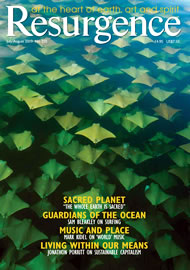Ailton Krenak is a charismatic leader of the Krenak people in Brazil, an ethnic group who seemed to be on the verge of extinction in the 1950s. Fortunately, their population has since recovered to around 450 people spread throughout three Brazilian states. Ailton has revived the Tarú Andek (literally meaning ‘getting closer to the sky’), an annual celebration that reunites the widely dispersed Krenak people so that they can practise the rituals of their sacred sites. This is part of an ongoing process to strengthen their culture. Ailton believes that protecting and reviving rituals linked to sacred sites is at the heart of any work to strengthen the resilience of Indigenous communities. Ailton was awarded the Onassis International Prize in 1990 for bringing together Indigenous peoples and rubber tappers for the protection of the forest.
How do sacred sites relate to the wider landscape?
Sacred sites are always related to the origins of Indigenous people. These origins are communicated through narratives and myths, so that every detail of a landscape gains meaning. The rivers, valleys, mountains, volcanoes and forests gain personality and spirit. They become beings with stories that tell of the culture and thinking of a community.
The community itself is an extension of this manifested world, with its children, grandchildren, nephews and nieces, all feeling ties to these entities. In each culture, you can see in its practices and rites, different ways of living and seeing the world. These are the natural rules that lead to relationships of reciprocity and that express a worldview that integrates human beings with their non-human parents in the universal order.
Sacred sites are where we gain meaning for our existence, but there are some Indigenous people who have been strongly influenced by missionaries and have lost their culture and identity. Even though they respected their cultural heritage, they eventually surrendered to outside pressure for new types of relationship towards their territory and sacred sites, which changed their real and symbolic understanding to an economic or market-oriented belief-system.
We, the Krenak, have been suffering this pressure for the last 200-300 years. But there is resistance, and for those who resist, the meaning of a sacred place is as alive as the sun, which we greet by dancing and chanting every morning: Tepó Itxá! Tepó ere-rré – ‘the sun comes hot, the sun comes to bless us’.
Many of the Indigenous families who live in their original place, where the sacred sites are, and who live from collecting and using Nature’s abundance for their food, shelter and cultural practices, still guide their lives following their traditional cultural beliefs. These practices prevail over outside government norms, so that traditional governance is established among the families in a system of reciprocity, and its rites and commitments are tuned to local ecological cycles, like the harvest, and fishing and hunting seasons. A participatory approach is established by the exchange of favours among community members, whilst constantly nurturing the balance between community and Nature.
You have been involved in rebuilding the Krenak community and reviving your rituals around sacred sites. Could you tell us more about this?
Our history must be understood in the Brazilian context; a country colonised by foreigners and with our people driven to the brink of extinction. The families who survived now live in small areas of our greater cultural territory, now called ‘Indigenous reserves’. Well, these Indigenous reserves are an aberration! Human beings, be they Indigenous or not, should never be subject to this kind of confinement without liberty to move and act.
Out of this reality, we managed to raise awareness of the meaning of sacred sites to our people. Sacred sites correspond to our landscape and topography, to the geography of our cultural history. In this way our territory is full of symbolism that enriches our narratives, linking every element to some action and meaning within our culture and myth.
We saw beyond the limits of the reserve that the Brazilian state gave us. We identified a constellation of sacred sites which we needed to express our traditions and rites in a way that transcends the simple ownership of a certain geographic area. The sites became nourishment for our spirit and for the communion with our ancestors, our origins.
This brought hope to generations of Krenak who felt they were in exile. Now we can practise our Tarú Andek – an important rite of Krenak tradition which was being forgotten and which is now being recovered in several sites.
You invited other tribes from other regions to join your celebration. What was your vision behind this?
We invited other people to share our celebration. They bring some of their own cultural practices, which makes it more fun for everyone. It has also inspired many of these tribes to revive their own rituals, with repercussion in their own regions, strengthening the vitality of Indigenous traditions all over Brazil.
Do you believe that sacred sites can help humanity to deal with our present challenges on Earth?
Sacred sites regulate life quality wherever they are located, and this reflects at a global scale. There is a connection between global equilibrium and the existence of these places where the Earth rests. Sacred sites have been so called by traditional and Indigenous peoples who have attested for thousands of years to the veracity of the myths and traditions relating to these places. By being loyal to ancestral rules and laws that regulate our relationship with Nature, many have resisted the temptation of ‘progress’ and continue to lead a simple way of life, taking the minimum possible from Nature to ensure a healthy, cultural and spiritually creative life which does not impact global integrity. Our ways of life should be taken as an example of good living, to be multiplied on a global scale to address today’s challenges. •
Lara Lutzenberger runs Fundação Gaia in Porto Alegre, Brazil, the legacy of her well-known father, José Lutzenberger.







